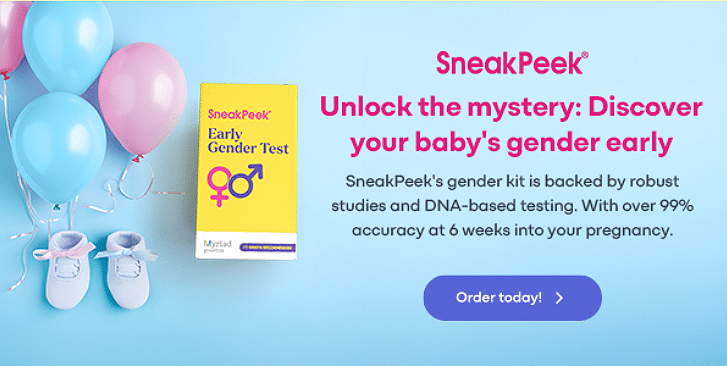Published on April 30th, 2023 and Updated on June 11th, 2025
Check out SneakPeek Gender Test to find out your baby’s gender as early as 6 weeks at over 99% accuracy1!

Implantation cramps can be a normal part of a healthy pregnancy, despite being a touch uncomfortable. The biggest myth surrounding them is that this mild cramping is brought on by the physical act of the fertilized egg penetrating the uterine wall—not so!
When implantation occurs, a future baby is only a minuscule cluster of cells (or blastocyst). At just the size of a poppyseed, they’re too small to cause pain or mild cramps by sheer might. Rather, implantation cramps are triggered by the hormones that help your little poppyseed get cozy in its new environment.
Whether you’re actively trying to get pregnant or wondering what those twinges in your abdomen are, demystifying reproductive aches and pains, and every cramp can help you become more fluent in your reproductive health. Below, we take a look at how long implantation cramping lasts, what causes implantation cramps, and our top tips for finding relief.
And if you want to learn more about distinguishing implantation cramping from other types of cramps, including pregnancy cramps vs period cramps, check out our guide on the first signs of pregnancy.
What causes implantation cramping?
Implantation cramping may result in some discomfort, but it’s a cramp that’s a perfectly healthy part of early pregnancy. To understand why this type of mild cramping occurs, let’s look at the chain of microscopic reproductive events that causes it:
- After an egg is fertilized by a sperm cell in the fallopian tube, it continues to float down toward the uterus while it develops a more complex cell structure.
- When it gets to the uterus, it must burrow into the endometrium to reach the next stage in its development: becoming an embryo. To do this, the body disburses prostaglandins—a key reproductive hormone that helps disintegrate the blastocyst’s outer layer so that it can implant.
- One common consequence of prostaglandin is minor muscle spasms. In some women, this can lead to the mild pain we recognize as implantation cramping.
Most implantation cramping occurs between 6 and 10 days after fertilization has occurred.
Cramping may also be accompanied by implantation bleeding—very light, pink-colored bloodshed that results from a blastocyst nestling into the uterine wall. This sometimes looks similar to the light spotting you may experience before your period. However, not all women observe blood during implantation.
What do implantation cramps feel like?
For most women, implantation cramps kick in around 3 weeks after the first day of their last menstrual cycle. The closeness in timing to PMS is why many women confuse implantation pain with their usual premenstrual symptoms.
Fortunately, if you’ve been trying to get pregnant and want to distinguish between implantation cramps and your run-of-the-month menstrual cramps or other mild cramps, there are five main differences to look out for:
- Implantation cramps tend to be milder, less severe, and less persistent than menstrual cramps
- Implantation cramps should subside after 3 days (maximum)
- Implantation cramps usually feel dull, while period cramps typically feel sharp and acute
- Implantation cramps are generally restricted to the lower abdomen, while menstrual cramps may be felt around the pelvic area and lower back
- Many women feel a “tugging” or pins-and-needles sensation alongside their implantation cramping
How long does implantation cramping last?
Most implantation cramping doesn’t hang around longer than three days, and in many cases, it dissipates in one. Some women don’t even sense any cramping at all.
If pain persists, it may be a sign that something’s amiss. In this case, it’s crucial to consult with your physician to rule out any preexisting health conditions or early pregnancy complications.
Do all women get implantation cramps?
Implantation must occur for a pregnancy to be viable, but not all women experience implantation cramping in the process (just as not all women experience implantation bleeding). Some women may experience small discharge during implantation – read about how to tell the difference between regular discharge vs pregnancy discharge.
Implantation Cramping: What’s Not Normal
If you’ve been trying to get pregnant, it’s vital to know what is and isn’t normal when it comes to implantation cramping. For instance, some women believe the cramping they’re experiencing is the result of implantation when it’s really routine period cramps. Other times that mildly uncomfortable “pulling” feeling could simply be ovulation (a sensation known as mittelschmerz).
In more severe cases, serious conditions can be mistaken for implantation cramping. To ensure you know what symptoms require further diagnosis and treatment, let’s take a look at what’s not normal and the reproductive complications they may indicate.
Miscarriage
An early miscarriage refers to any pregnancy loss that occurs earlier than 5 weeks into pregnancy. At this stage, most healthcare practitioners would call this a chemical pregnancy, which is believed to encompass as many as a third of all pregnancies.
Plausible signs of a miscarriage can include:
- Heavy bleeding
- Experiencing a loss of early pregnancy symptoms, like nausea or frequent urination
- Receiving a positive result on a pregnancy test followed by a negative pregnancy test
- Cramping that’s more severe or persistent than both implantation and menstrual cramping
Some women may be more prone to early miscarriage than others, including:
- Women who are over the age of 35
- Women who have a history of miscarriage
- Women under excessive psychological stress
- Women with type 1 or type 2 diabetes
- Women who use nicotine, alcohol, or other recreational drugs
If you’re worried you’ve experienced an early miscarriage, you can contact your primary care provider to confirm your diagnosis through testing.
Ectopic Pregnancy
Most pregnancies begin in the fallopian tube, where the sperm normally fertilizes an egg. In abnormal circumstances, a fertilized egg may seek implantation in the fallopian tube rather than the uterus—a condition that can result in an ectopic pregnancy.
Ectopic pregnancies are serious, dangerous conditions that can cause a rupturing of the fallopian tubes and even death. They must be diagnosed and treated as early as possible to ensure the health and recovery of the mother.
While symptoms of an ectopic pregnancy can resemble implantation cramping early on, they’re usually accompanied by:
- A progressive worsening of cramping pain
- Progressively worsening blood loss
- Pain restricted to one region of the pelvic area or abdomen
In the case that an ectopic pregnancy causes damage to the fallopian tube, women may also experience:
- Severe pain around the shoulder
- Pressure and pain around the rectum
- Lightheadedness or loss of consciousness
- Nausea and vomiting
- Disorientation
If you’ve been trying for a baby and experience any of these symptoms, it’s important to seek emergency treatment immediately. Ectopic pregnancies are treatable when caught early, but they require surgery as quickly as possible to prevent damage and support a thorough recovery.
4 Remedies for Soothing Implantation Cramping
In the majority of cases, implantation cramping is normal, mild, and, overall, an excellent sign: It shows you’re learning to tune into your body’s cues—one of the most vital parts of a healthy pregnancy!
That said, just because cramping is normal doesn’t mean you have to grin and bear the discomfort. Below, find 4 effective techniques for soothing implantation cramps during this tender time.
#1 Try a Hot Water Bottle
Many women already have a well-loved hot water bottle they use to assuage period cramps, and it can be just as useful for finding peace when implantation cramping kicks in. Applying heat is one of the best ways to pacify muscle cramps of all causes—including the ones in your uterus!
If you don’t have a hot water bottle on hand, a long soak in a warm bath or a steamy shower can work by the same token. You might also try drinking beverages like cinnamon or ginger tea to warm yourself up internally and find relief.
#2 Prop Up Your Legs
Some women swear by elevating their legs as a way to reverse blood flow and minimize pelvic pain. You can try shimmying your legs up against a wall or simply lying down with a pillow propped beneath your pelvis.
#3 Stretch Out Your Hips
You may find that some semi-active stretches can help relieve implantation pain. Some prenatal yoga-inspired postures to try include:
- Seated wide-legged forward bend, which stretches the inner thighs
- “Happy baby” pose, which targets the hip joints
- Frog pose, which targets the groin and hips
- Wind-relieving pose, which helps massage the hip joints (with the bonus of relieving any gas buildup, another hallmark symptom of early pregnancy!)
Stretching out the affected area and regions surrounding it is also an excellent way of relieving stress, which can help attenuate any discomfort you may be experiencing.
#4 Use a Pregnancy-Safe Painkiller
Implantation cramping is mild by definition, but if your cramping is persistent, you might try using a pregnancy-safe OTC painkiller. The safest option available is acetaminophen, better known as Tylenol.
NSAIDs, or non-steroidal anti-inflammatory drugs, are a class of painkillers pregnant women should avoid using. These include:
- Ibuprofen
- Aspirin
- Naproxen
Whether you reach for an OTC medication or bliss out with your legs up the wall, remember: implantation cramps are a mild, short-lived phase of early pregnancy. Most mamas agree that the minor pain is well worth the major gain of your future little bundle!
Keep Tabs On Your Pregnancy Earlier with SneakPeek
No matter how far along you are, it’s normal to want to look ahead to the next stepping stone on your path to parenthood. Find answers to all your pregnancy questions on our blog, like when you will start showing and can you take a bath while pregnant? If you’re already daydreaming about your future baby, get to know the facts about them earlier with SneakPeek’s Early Gender DNA Test.
With this at-home gender blood test, you’ll learn your baby’s gender as early as 6 weeks into your pregnancy with over 99% accurate1 DNA-based results. SneakPeek tests are processed by labs, physician-reviewed, and quickly delivered alongside a downloadable report you can share with your care provider.
SneakPeek is also OBGYN’s #1 recommended early gender test, with the trust of 1 million moms behind it (and counting!). Put the power of science behind your pregnancy, and check out SneakPeek’s complete at-home test range today.
Editorial Policy
At SneakPeek, our commitment is to provide accurate, up-to-date, and reliable information to empower our readers. Our content is thoroughly researched, reviewed by medical experts, and fact-checked to ensure its credibility. We prioritize the well-being and education of our readers, and our editorial policy adheres to the highest standards of integrity and accuracy in all our articles.
This post has been reviewed for accuracy by:
Haley Milot, a highly skilled laboratory professional, currently serves as the Associate Director of Lab Operations at Gateway Genomics, the parent company of SneakPeek. Her extensive experience in laboratory management, spanning over seven years with Gateway Genomics, showcases her expertise in quality assurance, quality control, and the development of laboratory procedures. Haley's background includes pivotal roles in DNA extraction and purification, real-time qPCR, and specimen accessioning, underscoring her comprehensive understanding of laboratory operations and diagnostics. Her adeptness in managing complex laboratory functions and her deep knowledge of medical diagnostics make her a vital contributor to SneakPeek's innovative approach to prenatal testing.
Sources:
- The Bump. Pregnancy Week by Week: 4 Weeks Pregnant. https://www.thebump.com/pregnancy-week-by-week/4-weeks-pregnant
- VeryWell Health. What Are Implantation Cramps? https://www.verywellhealth.com/implantation-cramps-5203920
- Cleveland Clinic. Conception. https://my.clevelandclinic.org/health/articles/11585-conception
- The Bump. How to Recognize Implantation Cramps. https://www.thebump.com/a/what-are-implantation-cramps
- VeryWell Health. How Period vs. Early Pregnancy Cramps Feel. https://www.verywellhealth.com/period-cramps-vs-early-pregnancy-cramps-7097107
- Healthline. What’s a Chemical Pregnancy? https://www.healthline.com/health/pregnancy/chemical-pregnancy
- VeryWell Health. What Is a Chemical Pregnancy? https://www.verywellhealth.com/chemical-pregnancy-5116868
- Healthline. What Could Be Causing Pain in Your Pelvis? https://www.healthline.com/health/pain-in-pelvis
- Yoga International. Seated Wide-Legged Forward Bend. https://yogainternational.com/article/view/seated-wide-legged-forward-bend/
- Yoga Journal. Happy Baby Pose. https://www.yogajournal.com/poses/happy-baby-pose/
- The Yoga Collective. Frog Pose – Mandukasana. https://www.theyogacollective.com/poses/frog-pose-mandukasana/
- Healthline. How to Fart. https://www.healthline.com/health/digestive-health/how-to-fart
- The Bump. 15 Early Signs of Pregnancy. https://www.thebump.com/a/early-signs-of-pregnancy
- WebMD. 6 Ways to Ease Your Chronic Pelvic Pain. https://www.webmd.com/women/guide/ease-chronic-pelvic-pain
- GoodRx Health. What Over-The-Counter Pain Relievers Are Safe During Pregnancy? https://www.goodrx.com/health-topic/parenthood-pregnancy/pain-relief-safe-during-pregnancy








